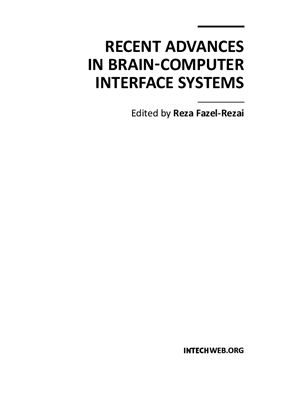Издательство InTech, 2011, -234 pp.
Communication and the ability to interact with the environment are basic human needs. Millions of people worldwide suff er from such severe physical disabilities that they cannot even meet these basic needs. Even though they may have no motor mobility, however, the sensory and cognitive functions of the physically disabled are usually intact. This makes them good candidates for Brain Computer Interface (BCI) technology, which provides a direct electronic interface and can convey messages and commands directly from the human brain to a computer. BCI technology involves monitoring conscious brain electrical activity via electroencephalogram (EEG) signals and detecting characteristics of EEG patt es via digital signal processing algorithms that the user generates to communicate. It has the potential to enable the physically disabled to perform many activities, thus improving their quality of life and productivity, allowing them more independence and reducing social costs. The challenge with BCI, however, is to extract the relevant patt es from the EEG signals produced by the brain each second.
A BCI system has an input, output and a signal processing algorithm that maps the inputs to the output. The following four major strategies are considered for the input of a BCI system: 1) the P300 wave of event related potentials (ERP), 2) steady state visual evoked potential (SSVEP), 3) slow cortical potentials and 4) motor imaginary. Recently, there has been a great progress in the development of novel paradigms for EEG signal recording, advanced methods for processing them, new applications for BCI systems and complete soft ware and hardware packages used for BCI applications.
In this book a few recent advances in these areas are discussed. In the fi rst chapter hardware and soft ware components along with several applications of BCI systems are discussed. In chapters 2 and 3 several signal processing methods for classifying EEG signals are presented. In chapter 4 a new paradigm for P300 BCI is compared with traditional P300 BCI paradigms. Chapters 5 and 6 show how a visual evoked potential (VEP)-based BCI works. In chapters 7 and 8 a visuo-motor-based and natural motor control-based BCI systems are discussed, respectively. New applications of BCI systems for control and biometry are discussed in chapter
9. Finally, the recent competition in BCI held in 2010 along with a short summary of the submitt ed projects are presented in Chapter 10.
Communication and the ability to interact with the environment are basic human needs. Millions of people worldwide suff er from such severe physical disabilities that they cannot even meet these basic needs. Even though they may have no motor mobility, however, the sensory and cognitive functions of the physically disabled are usually intact. This makes them good candidates for Brain Computer Interface (BCI) technology, which provides a direct electronic interface and can convey messages and commands directly from the human brain to a computer. BCI technology involves monitoring conscious brain electrical activity via electroencephalogram (EEG) signals and detecting characteristics of EEG patt es via digital signal processing algorithms that the user generates to communicate. It has the potential to enable the physically disabled to perform many activities, thus improving their quality of life and productivity, allowing them more independence and reducing social costs. The challenge with BCI, however, is to extract the relevant patt es from the EEG signals produced by the brain each second.
A BCI system has an input, output and a signal processing algorithm that maps the inputs to the output. The following four major strategies are considered for the input of a BCI system: 1) the P300 wave of event related potentials (ERP), 2) steady state visual evoked potential (SSVEP), 3) slow cortical potentials and 4) motor imaginary. Recently, there has been a great progress in the development of novel paradigms for EEG signal recording, advanced methods for processing them, new applications for BCI systems and complete soft ware and hardware packages used for BCI applications.
In this book a few recent advances in these areas are discussed. In the fi rst chapter hardware and soft ware components along with several applications of BCI systems are discussed. In chapters 2 and 3 several signal processing methods for classifying EEG signals are presented. In chapter 4 a new paradigm for P300 BCI is compared with traditional P300 BCI paradigms. Chapters 5 and 6 show how a visual evoked potential (VEP)-based BCI works. In chapters 7 and 8 a visuo-motor-based and natural motor control-based BCI systems are discussed, respectively. New applications of BCI systems for control and biometry are discussed in chapter
9. Finally, the recent competition in BCI held in 2010 along with a short summary of the submitt ed projects are presented in Chapter 10.

